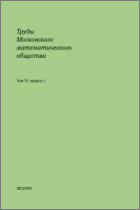|
|
Trudy Moskovskogo Matematicheskogo Obshchestva, 2022, Volume 83, Issue 1, Pages 63–75
(Mi mmo667)
|
 |
|
 |
Mathematical model of the spread of a pandemic like COVID-19
A. G. Sergeeva, A. Kh. Khachatryanb, Kh. A. Khachatryancd
a Steklov Mathematical Institute of Russian Academy of Sciences, Moscow
b National Agrarian University of Armenia
c Yerevan State University
d Institute of Mathematics, National Academy of Sciences of Armenia, Yerevan
Abstract:
Using the example of the infectious disease called COVID-19, a mathematical model of the spread of a pandemic is considered. The virus that causes this disease emerged at the end of 2019 and spread to most countries around the world over the next year. A mathematical model of the emerging pandemic, called the SEIR-model (from the English words susceptible, exposed, infected, recovered), is described by a system of four ordinary dynamical equations given in §1.
The indicated system is reduced to a nonlinear integral equation of Hammerstein–Volterra type with an operator that does not have the property of monotonicity. In §3, we prove a theorem on the existence and uniqueness of a non-negative, bounded and summable solution of this system.
Based on real data on the COVID-19 disease in France and Italy, given in §2, numerical calculations are performed showing the absence of a second wave for the obtained solution.
Received: 08.02.2021
Citation:
A. G. Sergeev, A. Kh. Khachatryan, Kh. A. Khachatryan, “Mathematical model of the spread of a pandemic like COVID-19”, Tr. Mosk. Mat. Obs., 83, no. 1, MCCME, M., 2022, 63–75
Linking options:
https://www.mathnet.ru/eng/mmo667 https://www.mathnet.ru/eng/mmo/v83/i1/p63
|

| Statistics & downloads: |
| Abstract page: | 315 | | Full-text PDF : | 159 | | References: | 44 |
|




 Contact us:
Contact us: Terms of Use
Terms of Use
 Registration to the website
Registration to the website Logotypes
Logotypes









 Citation in format
Citation in format 